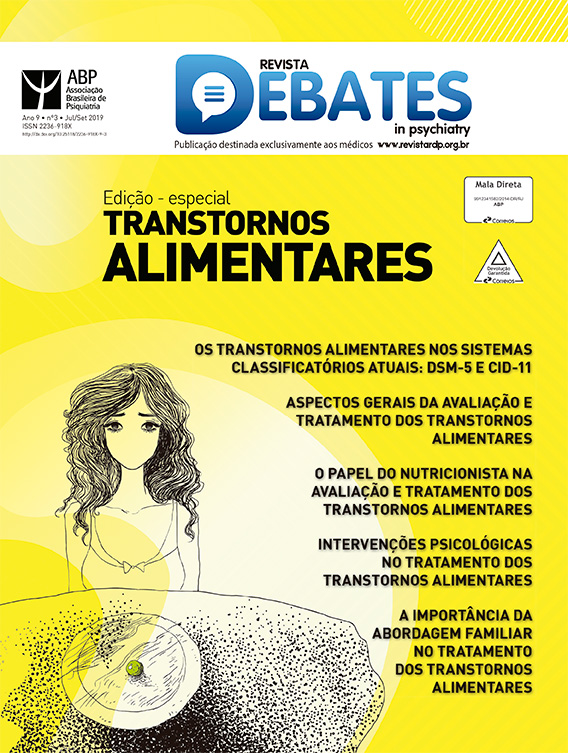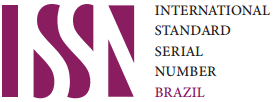General aspects of the assessment and treatment of eating disorders
DOI:
https://doi.org/10.25118/2763-9037.2019.v9.50Keywords:
Treatment, anorexia nervosa, assessment, eating disordersAbstract
Eating disorders are psychiatric conditions that present with intense psychological distress and severalclinical complications. The evaluation of patients with eating disorders usually requires a thorough history, detailed physical and psychiatric examination and complementary exams. This evaluation aims to establish a nosological diagnosis of the eating disorder and comorbidities and to stratify clinical and psychiatric risk, subsequently enabling therapeutic planning. Following this initial assessment, depending on case severity, the clinician will determine the recommended level of treatment, which may vary from hospitalization to regular outpatient treatment. Other decisions, such as the method of nutritional provision, initial calorie intake, and recovery goals, should also be previously defined. In this article we summarize some aspects related to assessment, comorbidities and general treatment instructions based on three international guidelines for the management and treatment of eating disorders, namely, two British guidelines, one from the National Institute for Health and Care Excellence (NICE) and the Management of Really Sick Patients with Anorexia Nervosa (MARSIPAN), and one Australian, prepared by the Royal Australian and New Zealand College of Psychiatrists (RANZ-CP).
Downloads
Metrics
References
Appolinario JC, Freitas S, Nazar BP; Programa de Atualização em Psiquiatria (PROPSIQ). Transtornos alimentares. In: Nardi AE, Silva AG, Quevedo JL, organizadores. Transtornos alimentares. 4ª ed. Porto Alegre: Artmed Panamericana; 2015. p. 43-93.
Associação Americana de Psiquiatria. Manual Diagnóstico e Estatístico de Transtornos Mentais, 5ª edição (DSM-5). Porto Alegre: Artmed; 2014.
Halmi KA. Salient components of a comprehensive service for eating disorders. World Psychiatry. 2009;8:150-5.
National Institute for Health and Care Excellence (NICE). Eating disorders: recognition and treatment [Internet]. NG69. 2017 May [cited 2020 Jan 14]. www.nice.org.uk/guidance/ng69
Hay P, Chinn D, Forbes D, Madden S, Newton R, Sugenor L, et al. Royal Australian and New Zealand college of psychiatrists clinical practice guidelines for the treatment of eating disorders. Aust N Z J Psychiatry. 2014;48:977-1008.
Hilbert A, Hoek HW, Schmidt R. Evidencebased clinical guidelines for eating disorders: international comparison. Curr Opin Psychiatry. 2017;30:423-37.
Allison E, Dawson N, Phillips J, Lynch C, Coleman J. Fifteen minute consultation: a structured approach to the management of children and adolescents with medically unstable anorexia nervosa. Arch Dis Child Educ Pract Ed. 2017;102:175-81.
Gibson D, Workman C, Mehler PS. Medical complications of anorexia nervosa and bulimia nervosa. Psychiatr Clin North Am. 2019;42:263-74.
Brown C, Mehler PS. Medical complications of anorexia nervosa and their treatments: an update on some critical aspects. Eat Weight Disord. 2015;20:419-25.
Quintana ABM, Assumpção CRL. Diagnóstico e manejo das condições clínicas associadas aos transtornos alimentares. In: Nunes MA, Appolinario JC, Galvão AL, Coutinho W, et al., editores. Transtornos alimentares e obesidade. 2ª ed. Porto Alegre: Artmed; 2006. p. 195-206.
Fazeli PK, Klibanski A. Effects of anorexia nervosa on bone metabolism. Endocr Rev. 2018;39:895-910.
Royal College of Psychiatrists. MARSIPAN: Management of really sick patients with anorexia nervosa [Internet]. 2nd ed. 2014 Oct [cited 2020 Jan 15]. www.rcpsych.ac.uk/docs/default-source/improving-care/better-mhpolicy/college-reports/college-report-cr189.pdf?sfvrsn=6c2e7ada_2
Mehler PS, O’Melia A, Brown C, Gibson D, Hollis J, Westmoreland P. Medical complications of bulimia nervosa. Br J Hosp Med (Lond). 2017;78:672-7.
Royal College of Psychiatrists. Junior MARSIPAN: management of really sick patients under 18 with anorexia nervosa [Internet]. Report CR168. 2012 Jan [cited 2020 Jan 15]. www.rcpsych.ac.uk/docs/default-source/improving-care/better-mhpolicy/college-reports/college-report-cr168.pdf?sfvrsn=e38d0c3b_2
Resmark G, Herpertz S, Herpertz-Dahlmann B, Zeeck A. Treatment of anorexia nervosa—new evidence-based guidelines. J Clin Med. Jan 29;8(2). pii: E153. doi: 10.3390/jcm8020153.
Falcão MA, Francisco R. Diabetes, eating disorders and body image in young adults: an exploratory study about “diabulimia”. Eat Weight Disord. 2017;22:675-82.
Garber AK, Sawyer SM, Golden NH, Guarda AS, Katzman DK, Kohn MR, et al. A systematic review of approaches to refeeding in patients with anorexia nervosa. Int J Eat Disord. 2016;49:293-310.
Rizzo SM, Douglas JW, Lawrence JC. Enteral nutrition via nasogastric tube for refeeding patients with anorexia nervosa: a systematic review. Nutr Clin Pract. 2019;34:359-70.
Friedli N, Stanga Z, Sobotka L, Culkin A, Kondrup J, Laviano A, et al. Revisiting the refeeding syndrome: results of a systematic review. Nutrition. 2017;35:151-60.
Bargiacchi A, Clarke J, Paulsen A, Leger J. Refeeding in anorexia nervosa. Eur J Pediatr. 2019;178:413-22.
Marvanova M, Gramith K. Role of anti depressants in the treatment of adults with anorexia nervosa. Ment Health Clin. 2018;8:127-37.
Hilbert A, Hoek HW, Schmidt R. Evidencebased clinical guidelines for eati ng disorders: internati onal comparison. Curr Opin Psychiatry. 2017;30:423-37.
Atti a E, Steinglass JE, Walsh BT, Wang Y, Wu P, Schreyer C, et al. Olanzapine versus placebo in adult outpati ents with anorexia nervosa: a randomized clinical trial. Am J Psychiatry. 2019;176:449-56.
Zipfel S, Giel KE, Bulik CM, Hay P, Schmidt U. Anorexia nervosa: aeti ology, assessment, and treatment. Lancet Psychiatry. 2015;2:1099-111.
American Psychiatric Associati on (APA). Practi ce guideline for the treatment of pati ents with eati ng disorders. 3rd editi on. American Psychiatric Associati on. 2006 Jun [cited 2020 Jan 15]. psychiatryonline.org/pb/assets/raw/sitewide/practice_guidelines/guidelines/eatingdisorders.pdf
Fairburn CG, Cooper Z, Doll HA, O’Connor ME, Bohn K, Hawker DM, et al. Transdiagnosti c cogniti ve-behavioral therapy for pati ents with eati ng disorders: a two-site trial with 60-week follow-up. Am J Psychiatry. 2009;166:311-9.
Himmerich H, Treasure J. Psychopharmacological advances in eati ng disorders. Expert Rev Clin Pharmacol. 2018;11:95-108.
Hudson JI, McElroy SL, Ferreira-Cornwell MC, Radewonuk J, Gasior M. Effi cacy of lisdexamfetamine in adults with moderate to severe binge-eati ng disorder: a randomized clinical trial. JAMA Psychiatry. 2017;74:903-10.
Appolinario JC, Nardi AE, McElroy SL. Investi gati onal drugs for the treatment of binge eati ng disorder (BED): an update. Expert Opin Investi g Drugs. 2019;28:1081-94.
Downloads
Published
How to Cite
Issue
Section
License

This work is licensed under a Creative Commons Attribution-NonCommercial 4.0 International License.
Debates em Psiquiatria allows the author (s) to keep their copyrights unrestricted. Allows the author (s) to retain their publication rights without restriction. Authors should ensure that the article is an original work without fabrication, fraud or plagiarism; does not infringe any copyright or right of ownership of any third party. Authors should also ensure that each one complies with the authorship requirements as recommended by the ICMJE and understand that if the article or part of it is flawed or fraudulent, each author shares responsibility.
Attribution-NonCommercial 4.0 International (CC BY-NC 4.0) - Debates em Psiquiatria is governed by the licencse CC-By-NC
You are free to:
- Share — copy and redistribute the material in any medium or format
- Adapt — remix, transform, and build upon the material
The licensor cannot revoke these freedoms as long as you follow the license terms. Under the following terms:
- Attribution — You must give appropriate credit, provide a link to the license, and indicate if changes were made. You may do so in any reasonable manner, but not in any way that suggests the licensor endorses you or your use.
- NonCommercial — You may not use the material for commercial purposes.
No additional restrictions — You may not apply legal terms or technological measures that legally restrict others from doing anything the license permits.






























